NEW YORK — An update on the 9th Avenue and 14th Street woonerf: The city has now installed a series of planters, café tables and chairs, newspaper boxes and benches in the newly created space. My last post showed a partial photograph of the empty square. Now, replete with seating and planters, this space has become a destination for residents and walkers to stop and have a coffee or to relax with a newspaper or book in a space that used to be an extensive triangular asphalt intersection.
Through the strategic location of planters and newspaper boxes, the space feels surprisingly safe and comfortable. Spaces of varying sizes, ‘rooms’, were created through the thoughtful consideration given to the location of these elements. Defining walking corridors and seating pods helps this area function as a pedestrian thoroughfare while providing removed and semi-private spaces for seating. The application of gravel to the existing asphalt further defines the area as a place for people not cars. Of the four or five times I have passed by this area it has been filled with people, even children running around and riding bikes. It looks like it’s already a success.
Click on photos to see larger versions
– – – – – – – – – – –
Joe Clement, a long-time Spacing magazine contributor, left his hometown of Toronto in August and is now living in New York. He will be our Big Apple correspondent covering public space issues.

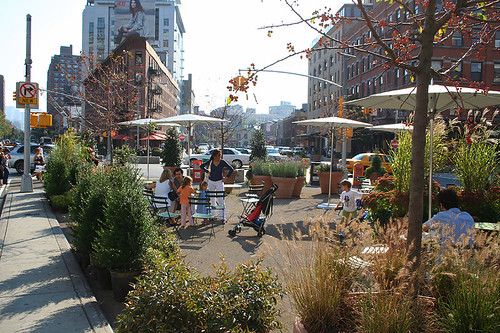
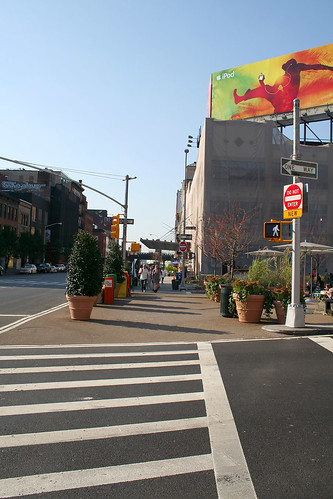
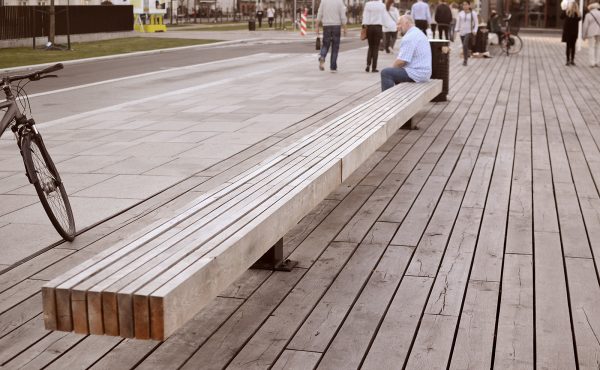
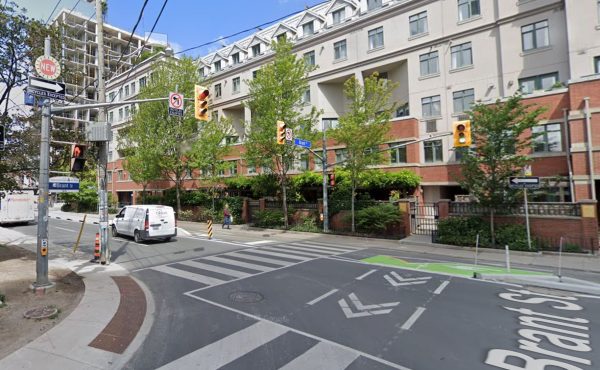
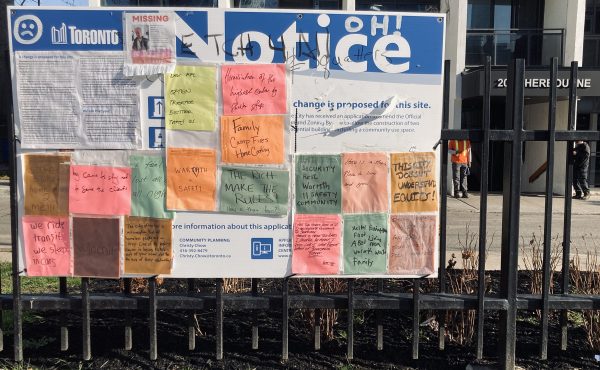
12 comments
Joe: To clarify, a woonerf is a shared space that still permits vehicular movement. I don’t see the woonerf here. These images suggest a “plaza in a porkchop”. The naked street is a variation on the shared space concept. Woonerf often have common traffic calming devices such as speed tables and horizontal shifts.
I don’t want to speak for Joe, but he knows what a Woonerf is. Please follow the link in the post to his previous post to see the exact nature of the intersection.
I saw something similar happening at Trinity St. & Front St. on the little island there. I didn’t get a close look but a small garden area has magically appeared there.
This is the beginning of a multi phase project which is currently in the midst of development. These elements are being introduced and some are there currently. You will notice on the bottom photo that curbs have been eliminated and a material change has been created to develop the differentiation between the street and pedestrian realm. I will keep updating this development and hopefully you will see the end product next summer.
>”plaza in a porkchop”
Because I know the area of Little W 12th St., and I know what a pork chop looks like, I can imagine what this phrase might mean: an urban park on a new traffic island in the middle of an irregular intersection, but uh…
What exactly is a “plaza in a porkchop”? This post is the only result on Google. It sounds interesting.
Matt: I’m sure Joe knows what a woonerf is, but none of the images in either post really show one. Shared spaces, naked streets and woonerfs are not synonymous. Woonerfs are more residential in nature. A Canadian example–although not really a design issue–might be Dave ‘Tiger’ Williams fighting for kids to play street hockey.
Kevin: A porkchop is like an island, an irregular leftover space after the roadways have taken their part. It’s a term I heard quite often while working in California.
Matt: I’m sure Joe knows what a woonerf is, but none of the images in either post really show one. Shared spaces, naked streets and woonerfs are not synonymous. Woonerfs are more residential in nature.
Kevin: A porkchop is like an island, an irregular leftover space after the roadways have taken their part. It’s a term I heard quite often while working in California.
Joe:
You may have written about it in one of your previous posts but what would you say if you were to compare Toronto and New York? Are there any woonerfs in your hometown?
Baray, woonerf’s do not have to be in residential areas or be residential in nature. Just because they occurred in this form in the past does not mean that they can’t re-interpret themselves around the world. After all, these types of irregular intersections demand a response that is not typical or formulaic. That’s why this particular project, still under development, is so interesting. What you are seeing is the first phase of this development.
I don’t know of any true woonerfs in Toronto, but I believe there is talk of creating one or something similar at the intersections of Bay and Bloor, and possibly Bay and Queen. Apparently there was lots of discussion about this at the Walk 21 Conference and I believe I heard about the Bay Street ideas through an interview by Matt Galloway on his show Here and Now on CBC Radio.
I like the idea of the so-called ‘living streets’, so I did a little research on the topic. I stumbled accross an article in Transportation Alternatives, which quoted Dylan Reid, member of the Toronto Pedestrian Committee as saying that “We [North Americans] like to define our spaces. We don’t like ambiguity”. This expert mentioned Toronto’s Kensington Market as a good example of woonerfs, with “its narrow streets, constant flow of pedestrians and cyclists and virtual lack of sidewalks (…) that already ensure a relatively harmonious existence between different modes of transport.”
In Dutch terms it doesn’t look much like a woonerf, which in Dutch traffic law and street level implementation is a larger zone on whose roads traffic takes second place to activities such as walking and play (speed +-6km/h with a max of 15) and is not simply excluded.
It’s going to be interesting to see how the word develops as it spreads into different social/transport cultures. Anecdotal experience from implementations in Spain suggests that slow/fast user divisions will be firmer than in northern Europe: here if you remove the barriers between sidewalk and street, you tend to end up with assholes driving fast along the sidewalk. It’s a bit like liberal democracy only flourishing where there are plenty of liberal democrats.